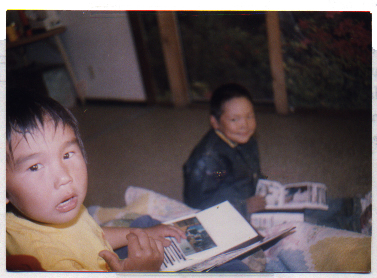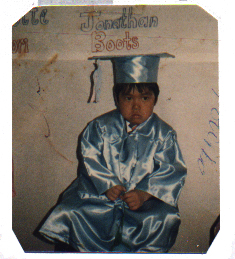Intellectual Development - Infancy:
INTELLECTUAL DEVELOPMENT
|
1 MONTH
|
General
Learns about the world by using all five senses.
Prefers to look at pattern objects and human faces.
Follows slowly moving object with eyes.
Listens attentively to sounds and voices.
Cries deliberately for assistance.
Language
Cries to express needs.
Is comforted by human voices and music.
|
|
2 MONTHS
|
General
Coordinates eye movements.
Is better able to follow moving objects with eyes.
Shows obvious preference of faces to objects.
Is clearly able to discriminate between voices.
Associates certain behaviors with certain people (such as mother with feeding).
Language
Makes some sounds, but most vocalizing is still crying.
Shows interest in sounds and will stop sucking to listen.
|
|
3 MONTHS
|
General
Is attentive for as long as 45 minutes at a time.
Shows memory by waiting for anticipated feeding.
Recognizes family members and familiar objects and sounds.
Likes to look at a variety of objects since vision has improved.
Is able to suck and look at the same time, thus doing two controlled actions at once.
Discovers hands and feet as extensions of self.
Searches with eyes for sounds.
Swipes at objects, but does not always may contact.
Language
Begins cooing one syllable, vowel-like sounds-ooh, ah, aw.
Squeals and chuckles.
Practices talking by making sounds, pausing, and making more sounds and a conversational rhythm.
|
|
4 MONTHS
|
General
Is alert up to an hour at a time.
Is aware of different depths and distances.
Likes to repeat enjoyable acts, like shaking a rattle.
Is able to discriminate among faces and may resent a strange face.
Shows interest in details of objects, such as shape, size, and texture.
Enjoys watching hands and feet.
Looks at object, reaches for it, and makes contact with it.
Language
Makes first consonant sounds-p, b, m, l.
Is able to babble strings of syllable-like sounds as if talking.
Smiles and coos when parent talks to him or her.
Prefers to babble when parent responds.
|
|
5 MONTHS
|
General
Is alert up to one and one-half hours at the time.
Can anticipate whole object when only part of object is visible.
May be able to play "peek-a-boo" and "hide-and-seek."
Reaches out for object and may be able to grab it awkwardly.
Recognizes and responds to own name.
Smiles at self in mirror.
Learns to differentiate between self and rest of world by comparing fingers to toys.
Language
Watches parents' mouth as they talk and experiments with one sounds.
Understands own name.
Can recognize people by their voices.
|
|
6 MONTHS
|
General
Is alert for two hours at a time.
Reaches out to grab objects with better aim and coordination.
Grabs any and all objects within reach.
Studies objects intensively, turning them to see all sides.
Learns that objects do not disappear when they are dropped; they simply fall to the floor.
Language
Makes more consonant sounds.
Repeat sounds to make two syllable "words."
Reacts appropriately to various tones of voice.
Carries volume, pitch, and rate while babbling.
|
|
7 MONTHS
|
General
Is aware of dimensions; can sort blocks according to size.
Begins to make simple associations.
Begins to show interest in the relationship between objects.
Responds with expectation to repetition of an event.
Enjoys looking through books with familiar pictures.
May begin to imitate an act.
Language
May have favorite, well-defined syllables.
Imitate sounds, tones of speech, and inflections.
"Sings" along with music.
May save mama or dada but does not connect with parents.
|
|
8 MONTHS
|
General
Learns to solve simple problems.
Likes to empty and fill containers, meanwhile learning concepts such as in, out, and "all gone."
Remembers past events and past actions.
Begins imitating behaviors of people.
Notices changes in the whole scene, such as a cup left on a table.
Begins to develop a sense of timing.
Understands cause and effect.
Language
Begins jargoning by putting together a long series of syllables.
Uses different inflections when jargoning.
May label object in imitation of its sound, such as choo-choo for train.
Begins to recognize some words
|

|
9 MONTHS
|
General
Recognizes dimensions of objects. Approaches small objects with hands, large objects with arms.
May show fear of height because of new understanding of distance.
May show some symbolic thinking.
Language
Responds appropriately to a few specific words.
Says a few words and adds appropriate gestures.
Says mama and dada as specific names.
May follow simple directions.
|
|
10 MONTHS
|
General
Is able to play games involving object permanence.
Will search to find hidden objects.
Likes to look for contents in a container.
Imitates behaviors in greater detail.
Language
Learns more words and appropriate gestures.
May repeat one word endlessly.
Likes to listen to familiar words and songs.
Understands and obeys simple words and commands.
|
|
11 MONTHS
|
General
Shows increased individuality in interest and abilities.
Can point to parts of the body.
Learns to make many kinds of associations.
Becomes even more skilled in imitation.
Knows the meaning of the word "no" but may disregard it.
Likes to look at pictures and books.
Language
Still uses jargoning, but includes some meaningful words.
Recognizes words as symbols for objects.
|
|
12 MONTHS
|
General
Solves simple problems.
Sets goal and takes action to achieve goal, as in pushing a chair in place to use for climbing.
Puts nesting toys together correctly.
May search for lost toys in more than one place.
May use a preferred hand.
Learns how to pick up and hold a third object.
Language
Begins to use language as an expression of self.
May have vocabulary of several words.
Knows words that imitate sounds of objects, such as bow-wow, etc.
|

|  This collection of student work is from Frank Keim's classes. He wants to share these works for others to use as an example of culturally-based curriculum and documentation. These documents have been OCR-scanned and are available for educational use only.
This collection of student work is from Frank Keim's classes. He wants to share these works for others to use as an example of culturally-based curriculum and documentation. These documents have been OCR-scanned and are available for educational use only.




